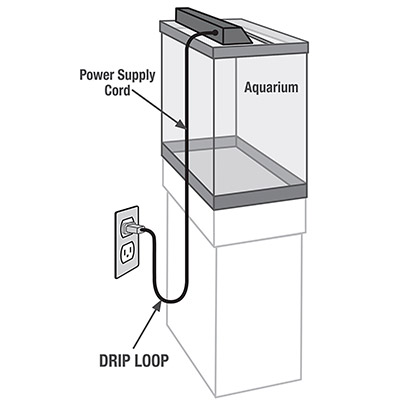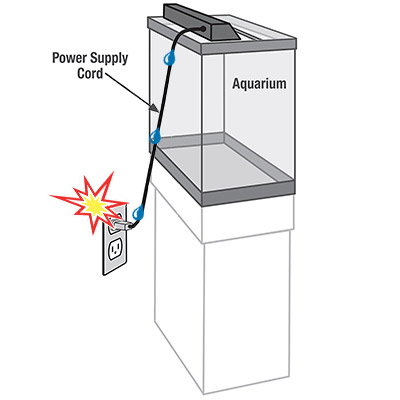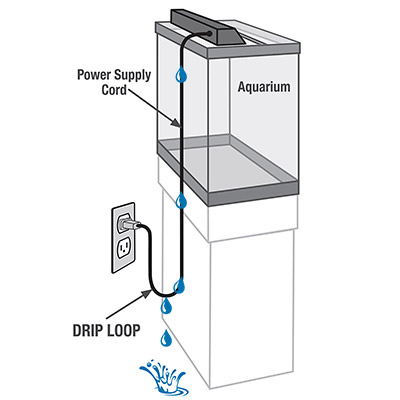So, you are setting up your new filter for your aquarium…
If you’re scratching your head wondering what on Earth a drip loop is, you’re not alone. It might sound like something fancy, but it’s actually quite simple and super essential for your aquarium’s electrical safety.
A drip loop is that little sag in the power cord that hangs below the outlet before looping back up. This nifty loop is your first line of defense against water meeting electricity, which, as we all know, is a match made in disaster heaven. Water trickling down the cord? No worries.
The drip loop catches it, sending droplets harmlessly onto the floor instead of into your power strip—preventing what could be a shocking experience!
Why bother with a drip loop? Because kaboom and electrocutions are bad news for everyone involved, especially your fish!
Setting one up is a breeze, and once you do, you’ll wonder how you ever went without it.
So, let’s dive into making your aquarium setup safer with a trusty drip loop. Trust me, your fish will thank you, and so will your wallet!
What is a drip loop?
A drip loop simply allows the cord to drop down below your outlet before rising back up to it.
Because a picture says a thousand words…

Yep, it’s just that little loop of hanging cord before your electrical outlet or power strip.
You should create a drip cord on all your electrical aquarium equipment, including:
- Filters
- Heaters
- Lighting
You know, anything that has a cord and needs to be plugged in.
Why is a drip loop important?
You know how electricity and water don’t mix? Well, consider a drip loop an extra line of defense to ensure that the two don’t meet.
Let’s say water drips down your power cord.
Without a drip loop, it’s going continue running down your cord until it flows into your electrical outlet.[1]

And, if water reaches your power outlet or power strip….
Kaboooooooom!
Do you really want to deal with that mess? Not to mention replacing the blown equipment that was plugged in at the time – which can be quite expensive!
Well, all that can be avoided if you use a drip loop…

Gravity is going to make sure that the water flows down to the lowest point, in this case your drip loop.
Because water can’t go against gravity, the water drips off the cord at its lowest point, keeping your electrical outlet safe.
Sure, the floor might get a little wet, but I’ll take that any day over paying to replace damaged electrical equipment.
Sometimes creating a drip loop is easier said than done. If your cord is particularly twisted and just doesn’t want to stay in place, you can always cheat.
And by cheat, I mean use a cable clip.
I prefer the screw-in type. Once it goes in, it stays in. If you prefer something that isn’t going to leave holes, then you can always use an adhesive cable clip like these ones – you can pick both up at your local hardware store.
Simply mount a cable clip below your electrical outlet or power strip, clip the loop of your cord in and just like that, your drip loop will keep its shape!
Not sold on a drip loop? You should be! Water running down your power cord is more common than you think.
How does the water get there?
- Spills during water changes
- Water droplets from lifting your heater out of the water
- Splashes from your filter outlet
- Water leaks
- Condensation
None of these scenarios are unrealistic. Each could happen to you!
And, a drip loop is so easy to create that there is almost no excuse for not creating one with the cords of your electrical equipment.
FAQs About Drip Loops in Aquariums
- Can I use a drip loop for all my aquarium electronics?
- Absolutely! It’s a smart idea to create a drip loop for every piece of electrical equipment associated with your aquarium. This includes filters, heaters, lighting systems, and air pumps. Essentially, if it plugs in, give it a loop to keep things safe and dry.
- What should I do if my power cord isn’t long enough to form a proper drip loop?
- If you find your power cord is too short to create an effective drip loop, consider using an extension cord that does allow for enough slack to form the loop. Just ensure that the extension cord is also appropriately rated for the equipment you’re using and is kept in a dry, safe location.
- Is there a risk in not using a drip loop for my aquarium setup?
- Skipping a drip loop does increase the risk of water finding its way into your electrical outlets or power strips, which can lead to dangerous short circuits, damaged equipment, or even fire. While it may seem like a small and perhaps insignificant step in setting up your aquarium, a drip loop provides a crucial layer of safety for you, your home, and your aquatic pets.
Do you create drip loops on your cords? Let me know in the comments below!

Ian Sterling, founder of Fishlab.com, began his aquarium journey over 30 years ago, driven by a deep fascination for fish and their diverse personalities. His website, Fishlab.com, is dedicated to making fishkeeping accessible and enjoyable, offering beginner-friendly guidance, expert insights, and a community for aquarists to connect and share experiences.




Comments (7)
What if I don’t have any of the things your talking about on hand right now what else can I do
Hi Dwayne,
You can use tape or just hang the drip loop if you want?
What if the power chord is not long enough to make a drip loop?
Hi Cindy, then you’ll have to either run the risk and be extra careful with spills or try and mcguyver a different solution.
How does one handle a proper drip loop set up with dozens of tanks?
My husband has a breeding set up of ~50 tanks in varying sizes..
These tanks are set up on double or triple shelf metal and wood racks.
A combination of power strips and expander plugs (the kind that turn the top or bottom segment of an outlet into 3 extra plugs to be used so that you have, say, 6 extra plug-in ‘opportunities’ on one wall or ceiling outlet – hope that makes sense).
It’s a smaller, but older home (~1200 sq. ft.) and I want to be sure we are all safe (kids and other pets in the home). The set up keeps growing.
I want to have the proper information for him in case we need to do things differently.
Thank you!
*A combination of power strips and expander plugs are being utilized
HI WLP,
While I get the rack setup, I am having difficulty picturing how it is cabled. Are you able to mount the electrical cables in the racks so that they are higher than the power outlet? That will go a long way towards preventing drips. In the case of power outlets, the loop should be placed before the outlet, so that no water can run off into it.